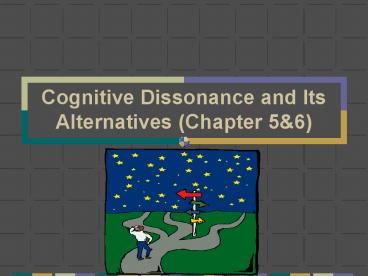Cognitive Dissonance and Its Alternatives Chapter 5 - PowerPoint PPT Presentation
1 / 17
Title:
Cognitive Dissonance and Its Alternatives Chapter 5
Description:
3 = Kid Rock. 4 = Matchbox 20. 5 = Feist. 6 = Foo Fighters. Post-decisional. 1 = Springsteen. 2 = Kid Rock. 3 = Annie Lennox. 4 = Feist. 5 = Matchbox 20. 6 = Foo ... – PowerPoint PPT presentation
Number of Views:101
Avg rating:3.0/5.0
Title: Cognitive Dissonance and Its Alternatives Chapter 5
1
Cognitive Dissonance and Its Alternatives
(Chapter 56)
2
Announcements
- Exam 2 is Thursday October 25th! Covers chapters
3-6, 13. - Study guide available during class today
- Questions? Please come see me or Elizabeth during
office hours or make an appointment.
3
Applications of Dissonance Theory
- Teaching children
- Children and robot toy study
- Kids given mild threat changed their attitude
more - Justification of effort
- Sexual discussion group study
- More embarrassment led to more liking for the
group
4
Applications of Dissonance Theory
- Derogation of victims
- Shocking a victim study
- If victim could not shock back, more attitude
change - Biased information searches
- Stupid and clever arguments study
- Remembered clever, consistent arguments and
stupid, inconsistent arguments
5
Applications of Dissonance Theory
- Post-decision dissonance dissonance that occurs
after making an important decision - We enhance the chosen item and derogate the
non-chosen item to justify our decision - Music CD study
6
- Original
- 1 Springsteen
- 2 Annie Lennox
- 3 Kid Rock
- 4 Matchbox 20
- 5 Feist
- 6 Foo Fighters
- Post-decisional
- 1 Springsteen
- 2 Kid Rock
- 3 Annie Lennox
- 4 Feist
- 5 Matchbox 20
- 6 Foo Fighters
7
Exactly when does dissonance lead to attitude
change?
- When there are negative consequences
- Boring task study revisited
- If told lie to non-participant, no attitude
change
8
Exactly when does dissonance lead to attitude
change?
- When individuals feel personal responsibility for
consequences - Tooth-brushing essay study
- If told purpose of essay after writing it, no
attitude change
9
Exactly when does dissonance lead to attitude
change?
- Arousal must be attributed to the dissonance
- If you are given another reason for the arousal,
no attitude change - Fake Drug study and Alcohol Study
10
Summary Assumptions of dissonance theory
- People have many pre-existing attitudes
- If we feel responsible for possible negative
outcomes, inconsistency between our attitudes and
behaviors creates negative arousal - To reduce dissonance (eliminate arousal) we may
change our attitudes to match our behaviors
11
Alternatives to Dissonance Theory
- Self-Affirmation theory (Steele)
- People do NOT have a need for consistency, they
just need to feel good about themselves. - Inconsistency makes people feel foolish
- If restore self-esteem, no attitude change -
maintaining self-esteem is key
12
Self-Affirmation Theory
- Lab coat studies
- Business majors and science majors wrote
counter-attitudinal essay - Everyone given lab coat to wear
- Science majors had no attitude change
13
Alternatives to Dissonance Theory
- Self-Perception theory (Bem)
- Often our attitudes are ambiguous or undefined
- We determine our attitudes through a process of
self-observation. We look to our behavior to
determine our attitudes.
14
Self-Perception Theory
- Boring task revisited
- People did not have a strong attitude toward task
- If people have no good external reason to say
task is fun, people infer that is their true
attitude
15
Self-Perception Theory
- Overjustification effect Rewards can make people
less interested in enjoyable activities - We assume our behavior is due to external reward
and not internal attitude - Only self-perception theory explains this!!!
16
Overjustification Effect
- Children and coloring study
- Three conditions expected reward, unexpected
reward, no reward - Later, kids in expected reward condition colored
less - Using rewards to stamp out undesirable behavior
17
Dissonance Versus Self-Perception
- Both suggest that attitudes follow from our
behavior - Dissonance Better at explaining attitude change
- Self-perception Better at explaining attitude
formation































